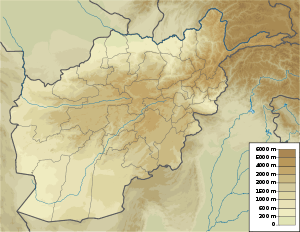National Airlines Flight 102
_of_National_Airlines_cropped.jpg) N949CA, the aircraft involved in the accident, in December 2012. | |
| Accident summary | |
|---|---|
| Date | 29 April 2013 |
| Summary | Stalled after load shift and impacted ground shortly after takeoff |
| Site |
Bagram Airfield, Parwan, Afghanistan 34°57′37″N 069°16′37″E / 34.96028°N 69.27694°E |
| Crew | 7 |
| Fatalities | 7 (all) |
| Survivors | 0 |
| Aircraft type | Boeing 747-428BCF |
| Aircraft name | Lori |
| Operator | National Airlines |
| Registration | N949CA |
| Flight origin | Camp Bastion |
| Stopover | Bagram Airfield |
| Destination | Dubai Al Maktoum |
National Airlines Flight 102 was a cargo flight operated by National Airlines between the British military base Camp Bastion in Afghanistan and Al Maktoum Airport in Dubai, with a refueling stop at Bagram Airfield, Afghanistan. On 29 April 2013, the Boeing 747-400 operating the flight crashed moments after taking off from Bagram, killing all seven people on board.[1][2]
Aircraft
The aircraft involved was a Boeing 747-428BCF,[note 1] registration N949CA,[3] S/N 25630.[4] It was manufactured in 1993 as a passenger aircraft[4] and later modified for service as a freighter before being sold to National Airlines. At the time of the crash, the aircraft was flying on behalf of the United States Air Force's Air Mobility Command.[1][5]
Accident

At the time of the crash the airline had been operating between Camp Bastion and Dubai for a month.[1] The accident flight had originated in Camp Bastion and had stopped at Bagram Airfield to refuel.[6][7] The aircraft then took off from Bagram's runway 03 at 15:30 local time and was climbing through 1,200 feet (370 m) when its nose rose sharply. According to an unconfirmed claim, a crew member was heard on VHF air-band radio reporting that some of the load of five heavy military vehicles in the cargo hold had shifted. The aircraft then stalled, crashed, and exploded into a large fireball.[1] The crash site was off the end of runway 03, within the perimeter of the airfield. All seven crew, all of whom were U.S. citizens,[5] died: four pilots, two mechanics, and a loadmaster.[1]
A thunderstorm was also in the vicinity of Bagram at the time of the crash and the wind changed direction by 120° during a one-hour period commencing approximately 35 minutes before the crash.[4] A dashboard camera on a car in the vicinity of the runway end recorded the crash and the video is available online.[1][8] CNN stated that a government official speaking on the condition of anonymity said that the video was authentic.[7]
Investigation
The United States National Transportation Safety Board (NTSB) and the Afghanistan Civil Aviation Authority investigated the crash.[5] The NTSB reported in a 30 April 2013 press release that representatives of the Federal Aviation Administration and the Boeing Company would also provide technical expertise and aid in the investigation.[9]
On 2 June 2013, investigators from the Ministry of Transport and Civil Aviation of Afghanistan confirmed the load shift hypothesis: three armoured vehicles and two mine-sweeping vehicles, totalling 80 tons of weight, had not been properly secured. At least one armored vehicle had come loose and rolled backwards against the airplane's rear bulkhead, damaging the bulkhead. This also crippled key hydraulic systems and damaged the horizontal stabilizer components, which rendered the airplane uncontrollable. [10] Control of the aircraft was therefore lost, with the abnormal pitch-up rotation, stall, and crash to the ground ensuing.[1]
Reactions
The crash interrupted the New Zealand Defence Force's (NZDF) withdrawal from Afghanistan, as it was only hours away from using another National Airlines aircraft to fly equipment out of the country; after the crash the NZDF indefinitely postponed using National Airlines for its airlift requirements.[11]
See also
- Asiana Airlines Flight 991
- Boeing 747 hull losses
- Fine Air Flight 101
- Korean Air Cargo Flight 6316
- UPS Airlines Flight 6
Notes
- ↑ The aircraft was a Boeing 747-400 model; Boeing assigns a unique code for each company that buys one of its aircraft, which is applied as an infix to the model number at the time the aircraft is built, hence "747-428". This aircraft was converted to freighter configuration as part of Boeing's conversion program of passenger 747-400s, hence "747-428BCF" for Boeing Converted Freighter.
References
- 1 2 3 4 5 6 7 Simon Hradecky (4 June 2013). "Crash: National Air Cargo B744 at Bagram on Apr 29th 2013, lost height shortly after takeoff". The Aviation Herald. Retrieved 5 June 2013.
- ↑ "Seven killed in US cargo plane crash at Afghan base". BBC News. 29 April 2013. Retrieved 1 May 2013.
- ↑ "FAA Registry". Federal Aviation Administration.
- 1 2 3 "N949CA accident synopsis". Aviation Safety Network. Retrieved 9 May 2013.
- 1 2 3 Yan, Holly; Alsup, Dave (1 May 2013). "Cargo plane crashes in Afghanistan, killing 7 Americans". CNN. Retrieved 1 May 2013.
- ↑ "Information Related to Flight NCR102". National Air Cargo. Archived from the original on 3 May 2013. Retrieved 6 May 2013.
- 1 2 "Video of Bagram plane crash legitimate, U.S. official says". CNN. 6 May 2013. Retrieved 6 May 2013.
- ↑ https://www.youtube.com/watch?v=mSuHAIRWSHE
- ↑ "NTSB to assist Afghan authorities with investigation into Bagram cargo plane crash". NTSB Press Releases. National Transportation Safety Board. Retrieved 5 May 2013.
- ↑ "NTSB Finds Damage From Inadequately Secured Cargo Caused Boeing 747 Crash in Bagram, Afghanistan". NTSB Press Release dated 14 July 2015. National Transportation Safety Board. Retrieved 18 Oct 2015.
- ↑ "Plane crash stalls Afghan withdrawal". 3 News NZ. 2 May 2013. Retrieved 2 May 2013.
External links
- NTSB preliminary report
- NTSB Final Aircraft Accident Report
- "Information Related to Flight NCR102." National Air Cargo (Archive)
- "STATEMENT FROM NATIONAL AIR CARGO." EVA International Media. 2 May 2013. (Archive)
- Dashcam footage from vehicle – LiveLeak; Boeing 747 stall and crashes – YouTube